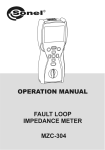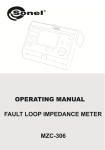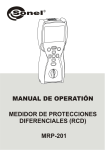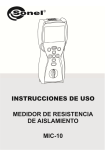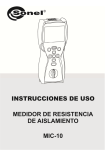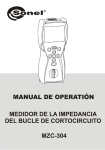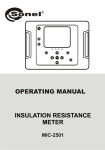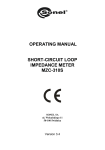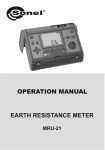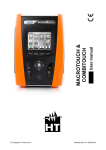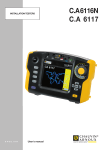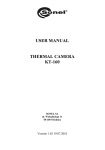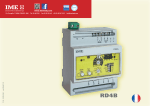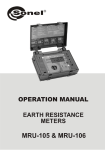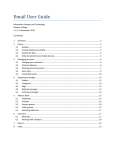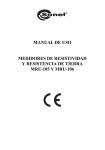Download User Manual
Transcript
OPERATION MANUAL
RCD TESTER
MRP-201
MRP-201
Measuring terminals
Start the
measurement
procedure
ESC - return to previous function,
exit the function
Contact
electrode
SET/SEL - - used for
entering meter settings and
selecting the digit to be
changed
Shift/selection:
right / left,
up / down
Approving selected function
ROTARY SWITCH FOR SELECTING FUNCTIONS
Selecting the measurement function:
- tA 0,5x - RCD: response time measurement for 0,5IDn
- tA 1x - RCD: response time measurement for 1IDn
- tA 2x - RCD: response time measurement for 2IDn
- tA 5x - RCD: response time measurement for 5IDn
- AUTO - RCD: automatic measurement
- IA
- RCD: response/tripping time measurement
- U,f - measurement of voltage and frequency
- MEM - View and erase the memory content and
data transmission
On and off function keep the button depressed
for some time to turn on
(in two steps) and off the
display lighting
DISPLAY
Parameter configuration mode active
Units of displayed
on the additional
field
Maximum allowed temperature
inside the meter is exceeded.
Ready for
measurement
L and N leads
switched
READY
Memory storing or memory
viewing mode active
SET
MEM
!
NOISE!
Additional display field
Values displayed on
the additional field
IDn multiplication factor
Safe contact voltage
RCD type
Current waveform
Main reading field
Interference voltage causing
additional measurement uncertainty
UN
IDn
IDn x1/25
UL =12.50V
AC
AB S G
Bank Cell
Memory bank and memory
cell number
V
mA
tAI
L-N
L-PE RCD
Symbol indicating
battery charge status
RE UBIA
ms?
mk
VHz
m A
Warning - important error message
displayed, read the operating manual
Values displayed on the main field
Units of displayed on the main field
OPERATING MANUAL
RCD TESTER
MRP-201
SONEL SA
ul. Wokulskiego 11
58-100 Świdnica, Poland
Version 1.05
07.01.2015
The MRP-201 meter is a modern, easy and safe measuring device. Please acquaint yourself with the
present manual in order to avoid measuring errors and prevent possible problems related to operation
of the meter.
2
CONTENTS
1
SAFETY ....................................................................................................................5
2
MEASUREMENTS ..................................................................................................6
2.1
2.2
2.3
2.4
2.5
2.6
2.6.1
2.6.2
2.6.3
3
SELECTION OF GENERAL MEASUREMENT PARAMETERS .........................................6
REMEMBERING THE LAST MEASUREMENT RESULT ................................................7
MEASUREMENT OF ALTERNATING VOLTAGE .........................................................8
MEASUREMENT OF VOLTAGE AND FREQUENCY .....................................................8
VALIDATION OF THE CONNECTIONS THE PROTECTIVE CONDUCTOR .......................8
MEASUREMENT OF RCD PARAMETERS .................................................................9
Measurement of RCD disconnection current .................................................9
Measurement of RCD disconnection time ....................................................12
Automatic measurement of RCD parameters...............................................14
MEMORY OF MEASUREMENT RESULTS.....................................................22
3.1
3.2
3.3
3.4
3.4.1
3.4.2
3.5
3.5.1
3.5.2
STORING THE MEASUREMENT RESULT DATA IN THE MEMORY .............................22
CHANGING THE CELL AND BANK NUMBER ...........................................................24
VIEWING MEMORY DATA.....................................................................................24
DELETING MEMORY DATA ...................................................................................25
Deleting bank data.......................................................................................25
Deleting the whole memory .........................................................................26
COMMUNICATION WITH PC .................................................................................27
Computer connection accessories ...............................................................27
Data transmission ........................................................................................27
4
TROUBLESHOOTING .........................................................................................29
5
METER POWER SUPPLY ...................................................................................31
5.1
5.2
5.3
MONITORING OF THE POWER SUPPLY VOLTAGE ...................................................31
REPLACING BATTERIES (RECHARGEABLE BATTERIES) .........................................31
GENERAL PRINCIPLES REGARDING USING NI-MH ACCUMULATORS .....................33
6
CLEANING AND MAINTENANCE....................................................................34
7
STORAGE ..............................................................................................................34
8
DISMANTLING AND UTILISATION ................................................................34
9
TECHNICAL SPECIFICATIONS .......................................................................35
9.1
9.2
10
BASIC DATA ........................................................................................................35
ADDITIONAL DATA ACCORDING TO IEC 61557-6 (RCD) .....................................38
EQUIPMENT .........................................................................................................39
3
10.1
10.2
11
4
STANDARD EQUIPMENT .......................................................................................39
OPTIONAL ACCESSORIES .....................................................................................39
MANUFACTURER ...............................................................................................40
1
Safety
MRP-201 meter is designed for performing check tests of protection against electric shock in
mains systems. The meter is used for making the measurements the results of which determine
safety of electrical installations. Therefore, in order to provide conditions for correct operation and the
correctness of the obtained results, the following recommendations must be observed:
Before you proceed to operate the meter, acquaint yourself thoroughly with the present manual
and observe the safety regulations and specifications determined by the producer.
Any application that differs from those specified in the present manual may result in a damage to
the device and constitute a source of danger for the user.
The device must be operated solely by appropriately qualified personnel with relevant certificates
to realise measurements of electric installation. Operation of the meter realised by unauthorised
personnel may result in damage to the device and constitute a source of danger for the user.
Using this manual does not exclude the need to comply with occupational health and safety
regulations and with other relevant fire regulations required during the performance of a particular
type of work. Before starting the work with the device in special environments, e.g. potentially firerisk/explosive environment, it is necessary to consult it with the person responsible for health and
safety.
It is unacceptable to operate the following:
A damaged meter which is completely or partially out of order,
A meter with damaged test leads insulation,
A meter stored for an excessive period of time in disadvantageous conditions (e.g. excessive
humidity). If the meter has been transferred from a cool to a warm environment of a high level
of relative humidity, do not realise measurements until the meter has been warmed up to the
ambient temperature (approximately 30 minutes).
It should be remembered that BAT message appearing on the display indicates that supply
voltage of the meter is too low. This message signals also that the batteries must be replaced or
the accumulator charged. Measurements performed by means of the meter whose supply voltage
is too low are burdened with additional errors that are impossible to be estimated by the user.
Such measurements must not be relied on in order to state correctness of protection of a network
tested.
Battery spill and damage to the meter may occur if discharged batteries are left in the meter.
Before measurements may commence, make sure the test leads are connected to the
appropriate measurement sockets.
Do not operate a meter with an open or incorrectly closed battery (accumulator) compartment or
power it from other sources than those specified in the present manual.
Repairs may be realised solely by an authorised service point.
ATTENTION!
Only standard and additional accessories for a given device should be used, as listed in
the "Equipment" section. Use of different accessories can lead to errors in the test
connection and can introduce additional measurement uncertainties.
Note:
An attempt to install drivers in 64-bit Windows 8 may result in displaying "Installation
failed" message.
Cause: Windows 8 by default blocks drivers without a digital signature.
Solution: Disable the driver signature enforcement in Windows.
5
Attention:
Due to continuous development of the meter’s software, the actual appearance of the
display, in case of some of the functions, may slightly differ from the display presented in
this operating manual.
2
Measurements
WARNING:
During RCD measurements, the earthed parts and parts accessible in the electrical
installation being tested must not be touched.
WARNING:
During a measurement, switching of the range switch is forbidden because it may damage
the meter and pose a threat to the user.
2.1
Selection of general measurement parameters
Keeping the SET/SEL button
depressed, turn on the meter and wait
for the parameter selection screen.
Use the
,
parameter.
buttons to go to the next
Use the
,
buttons to change the parameter
value. The value or symbol to be changed is
flashing.
The
symbol indicates an active parameter,
the
- symbol indicates an inactive one.
Set the parameters according to the following algorithm:
6
Parameter
Auto-OFF
Parameters
RCD-AUTO
Change
PIN
Power
source
Beeper
Program
update
Symbol(s)
Parameter
symbol(s)
...
Press ENTER to validate the last change and go to
the measurement function,
or
Press ESC to go the measurement function without
validating the changes.
Notes:
- Symbol
in this case indicates positive phase/polarity, while symbol
applies to pulsed and direct current.
- Symbol
indicates that no auto-off time has been set.
- RCD Auto mode settings are described in Section 2.6.3.
- PIN settings - see section 3.5.2 Data Transmission.
2.2
- negative. The same
Remembering the last measurement result
The result of the latest measurement is remembered by the meter until a next measurement is
started or measurement settings are changed or the measuring function is changed by means of the
rotary switch or the meter is switched off. When you go to the output screen of a given function, you
can recall this result with the ESC button by pressing ENTER. Similarly, you can view the latest
measurement result after turning off and then turning on the meter (if the position of function selector
has not been changed).
7
2.3
Measurement of alternating voltage
The meter measures and displays alternating mains voltage in all measuring functions. This
voltage is measured for the frequencies within the range of 45..65 Hz. The test leads should be
connected as for a given measuring function.
2.4
Measurement of voltage and frequency
Set the rotary switch in the U,f
position.
Read the result of
measurement: the
voltage on the
secondary display
field, the frequency of
the principal.
2.5
Validation of the connections the protective conductor
After connecting the meter according to the
drawing, touch the contact electrode with a finger
and wait for about 1 second. When voltage is
found on PE the meter displays symbol (error
in the installation; PE connected to the phase
conductor) and generates a continuous beep.
This option is available for all measuring
functions of residual current devices (RCD).
Notes:
WARNING:
When a dangerous voltage is detected on PE conductor, measurements must be immediately stopped and a fault in the installation must be removed.
8
- The person making a measurement must ensure that he/she is standing on a non-insulated floor
during the measurement; otherwise the result of the measurement may be incorrect.
- The threshold value, which triggers the signal of exceeded allowable voltage on PE conduit, is
approximately 50 V.
2.6
Measurement of RCD parameters
2.6.1 Measurement of RCD disconnection current
Turn on the meter.
Turn the rotary switch
to the position IA.
Set the parameters according to the following algorithm, and
according to the rules described in general parameters setting.
Parameter
In
Current
waveform
Type
of switch
UL
Measurement
mode
9
Connect
the test
leads
as shown
on the
drawing.
Connecting
N
conductor
is
necessary
for pulsed
current
with direct
current
offset and
for direct
current.
The meter is ready
for measurement.
UL-PE voltage
Perform measurement by pressing START pushbutton.
Read the main
measurement result
IA current.
To read additional results, press
10
.
Response
time tAI at IA
current.
UB contact
voltage.
Resistanceto-earth RE
Notes:
- The value of I∆n and its multiplication factor along with current waveform must be selected in a
manner enabling the meter to perform the measurement. The set of measurement parameters, which
is not supported by the meter, can not be entered - when one parameter is entered the remaining
parameters change their values to default values (see Technical Specifications: Table of forced
current values).
- Measurement of response time tAI is not available for short-time delay switches and for selective
switches and for direct current.
- UB and RE values are measured with test current 0,4I ∆n without RCD tripping. If during this
measurement RCD is tripped, the following message
is displayed for a while and the next
measurement (if applicable) (IA or tA) will not be performed.
- Due to the nature of the measurement (increase of I Acurrent in steps), measured
disconnection/response time tAI in this mode may include a positive error or as a result of RCD inertia,
the following symbol may be displayed:
. If the result is not within the acceptable range for a given
RCD, repeat the measurement in tA mode (section 2.6.2).
- Enter the result into memory (see section 3.2) or press, ESC, to return to displaying only voltage
value. The last measurement result is stored until START button is pressed again or the position of
rotary switch is changed.
11
Additional information displayed by the meter
The meter is ready for measurement.
Voltage on terminals L and PE is not within the
measurable range.
L and N conductors have been switched (voltage between
terminals PE and N).
The temperature inside the meter has risen above the
limit, the measurement is blocked.
RCD is inactive.
Safe contact voltage exceeded.
RE value is out of range.
The measurement cancelled with ESC.
The loss of voltage during the measurement.
or
After UB RE measurement, IA (or tA) measurement has not
been performed because the values of RE and mains
voltage did not allow to generate the required current
value.
Damaged current setting circuit. Try to perform
measurement again. If the message reappears, please
send the meter for repair.
2.6.2 Measurement of RCD disconnection time
Turn on the meter.
Turn the rotary switch
to a position for tA
measurement with
selected multiplication
factor of IΔn.
Set the parameters according to the following algorithm, and
according to the rules described in general parameters setting.
12
Parameter
In
Current
waveform
Type
of switch
UL
Measurement
mode
Connect
the test
leads
as shown
on the
drawing.
Connecting
N
conductor
is
necessary
for pulsed
current
with direct
current
offset and
for direct
current.
The meter is ready
for measurement.
UL-PE voltage
13
Perform measurement by pressing START pushbutton.
Read the main
measurement
result: tA disconnection
(response) time.
To read additional results, press
.
UB contact
voltage.
Resistanceto-earth RE
Messages and information displayed by the meter as in Section 2.6.1.
2.6.3 Automatic measurement of RCD parameters
The meter enables automatic measurement of the following: RCD disconnection times (t A),
disconnection current (IA), touch voltage (UB) and resistance-to-earth (RE). In this mode, there is no
need to trigger the measurement foe every single measurement and the role of the user is reduced to
initiate the measurement and switch on RCD after each tripping.
MRP-201 provides two AUTO modes to be chosen from the main menu:
- FULL mode
14
- STANDARD mode
Mode selection is described in Section 2.1.
2.6.3.1 FULL mode
Turn on the meter.
Turn the rotary switch
to AUTO position.
If displayed parameters differ from those required, set them
according to the following algorithm, and according to the rules
described in general parameters setting.
Parameter
In
Type
of switch
Type
of switch
UL
Connect
test leads
according
to the
drawing.
Connecting
N
conductor
is
necessary
for pulsed
current
with direct
current
offset and
for direct
current.
The meter is ready
for measurement.
15
UL-PEvoltage
Press START push-button to start measurement.
After each activation
turn-on tested RCD.
Read the main
measurement result:
- good or
-
bad.
Enter the result into memory by pressing ENTER, or see the components of the result
displaying voltage values by pressing ESC.
The meter provides the following measurements:
For RCD AC:
16
No.
Parameters
measured
1.
2.
3.
4.*
5.*
UB, RE
tA
tA
tA
tA
Measurement conditions
In
Initial phase (polarization)
multiplication
factor
0.5In
0.5In
1In
1In
positive
negative
positive
negative
and
go to
6.*
7.*
8.*
9.*
10.*
11.*
tA
positive
2In
tA
negative
2In
tA
positive
5In
tA
negative
5In
IA
positive
IA
negative
* points in which an efficient RCD should be disconnected
For RCD A:
No.
1.
2.
3.
4.*
5.*
6.*
7.*
8.*
9.*
10.*
11.*
12.*
13.*
14.*
15.*
16.*
17.*
18.*
19.*
20.*
21.*
22.*
23.*
24.*
25.*
26.*
27.*
28.*
29.*
30.*
31.*
Parameters
measured
Measurement conditions
In
Initial phase (polarization)
multiplication
factor
UB, RE
tA
positive
0.5In
tA
negative
0.5In
tA
positive
1In
tA
negative
1In
tA
positive
2In
tA
negative
2In
tA
positive
5In
tA
negative
5In
IA
positive
IA
negative
tA
positive
0.5In
tA
negative
0.5In
tA
positive
1In
tA
negative
1In
tA
positive
2In
tA
negative
2In
tA
positive
5In
tA
negative
5In
IA
positive
IA
negative
positive
tA
0.5In
negative
tA
0.5In
positive
tA
1In
negative
tA
1In
positive
tA
2In
negative
tA
2In
positive
tA
5In
negative
tA
5In
positive
IA
negative
IA
* points in which an efficient RCD should be disconnected
For RCD B:
No.
Parameters
measured
1.
UB, RE
Measurement conditions
In
Initial phase (polarization)
multiplication
factor
17
2.
3.
4.*
5.*
6.*
7.*
8.*
9.*
10.*
11.*
12.*
13.*
14.*
15.*
16.*
17.*
18.*
19.*
20.*
21.*
22.*
23.*
24.*
25.*
26.*
27.*
28.*
29.*
30.*
31.*
32.*
23.*
24.*
25.*
26.*
27.*
28.*
29.*
30.*
31.*
tA
tA
tA
tA
tA
tA
tA
tA
IA
IA
positive
negative
positive
negative
positive
negative
positive
negative
positive
negative
tA
positive
0.5In
tA
negative
0.5In
tA
positive
1In
tA
negative
1In
tA
positive
2In
tA
negative
2In
tA
positive
5In
tA
negative
5In
IA
positive
IA
negative
tA
positive
0.5In
tA
negative
0.5In
tA
positive
1In
tA
negative
1In
tA
positive
2In
tA
negative
2In
tA
positive
5In
tA
negative
5In
IA
positive
IA
negative
tA
positive
0.5In
tA
negative
0.5In
tA
positive
1In
tA
negative
1In
tA
positive
2In
tA
negative
2In
tA
positive
5In
tA
negative
5In
IA
positive
IA
negative
* points in which an efficient RCD should be disconnected
0.5In
0.5In
1In
1In
2In
2In
5In
5In
Notes:
- The number of measured parameters depends on the settings entered in the main menu.
- UB and RE are always measured.
- Automatic measurement is interrupted in the following cases:
the switch was tripped during the measurement of UB RE or tA at the half value of IΔn,
the switch did not trip during other component measurements,
the value of safe voltage UL has been exceeded,
voltage was disconnected during one of the component measurements,
18
the values of RE and mains voltage did not allow to generate the required current value for one of
component measurements.
- The meter automatically skips the measurements impossible to perform, e.g. the value of selected
IΔn current and its multiplication factor exceed the testing range of the meter.
- Criteria for assessing the correctness of component results:
0.5*IΔn ≤ IA ≤ 1*IΔn
0,35*IΔn ≤ IA
and
≤ 2*IΔn for IΔn =10mA
0,35*IΔn ≤ IA
and
≤ 1,4*IΔn for remaining IΔn
0.5*IΔn ≤ IA ≤ 2*IΔn
tA at 0.5*IΔn → rcd, for all types of RCD
tA at 1*IΔn ≤ 300ms for standard RCD's
tA at 2*IΔn ≤ 150ms for standard RCD's
tA at 5*IΔn ≤ 40ms for standard RCD's
130ms ≤ tA at 1*IΔn ≤ 500ms for selective RCD's
60ms ≤ tA at 2*IΔn ≤ 200ms for selective RCD's
50ms ≤ tA at 5*IΔn ≤ 150ms for selective RCD's
10ms ≤ tA at 1*IΔn ≤ 300ms for short-time delay RCD's
10ms ≤ tA at 2*IΔn ≤ 150ms for short-time delay RCD's
10ms ≤ tA at 5*IΔn ≤ 40ms for short-time delay RCD's
Additional information displayed by the meter
RCD in good working order.
RCD not in god working order.
Switch on the RCD.
Other information displayed by the meter as in Section 2.6.1.
2.6.3.2 STANDARD mode
Turn on the meter.
Turn the rotary switch
to
AUTO position.
If displayed parameters differ from those required, set them
according to the following algorithm, and according to the rules
described in general parameters setting.
19
Parameter
In
Current
waveform
Type
of switch
UL
Connect
test leads
according
to the
drawing.
Connecting
N
conductor
is
necessary
for pulsed
current
with direct
current
offset and
for direct
current.
The meter is ready
for measurement.
UL-PEvoltage
20
Press START push-button to start measurement.
After each activation
turn-on tested RCD.
Read the main
measurement
result:
- good or
- bad.
Notes:
- Measured parameters are the same as those presented in the table for FULL and RCD AC mode for
selected current waveform.
- Other messages and information as in Section 2.6.3.1.
21
3
Memory of measurement results
MRP-201 meters are equipped with the memory that can store 10000 single measurement
results. The whole memory is divided into 10 memory banks with 99 cells in each bank. Thanks to
dynamic memory allocation, each of the memory cells can contain different quantity of single
measurement results, depending on the needs. Optimal use of the memory can be ensured in this
way. Each measurement result can be stored in a memory cell marked with a selected number and in
a selected memory bank. Thanks to this, the user of the meter can, at his/her option, assign memory
cell numbers to individual measurement points and the memory bank numbers to individual facilities.
The user can also perform measurements in any sequence and repeat them without losing other data.
Memory of measurement results is not deleted when the meter is switched off. Thanks to this,
the data can be later read or sent to a computer. The number of a current memory cell or memory
bank is not changed either.
Note:
- Results of measurements performed for all measuring functions can be stored in one memory cell.
- After each entry of the measurement result to the cell, its number is automatically incremented. Set
the appropriate cell number to allow entering to a single cell of successive measurement results
relating to a given measuring point (facility).
- Only the results of measurements triggered by START push-button may be stored in the memory.
- It is recommended to delete the memory after reading the data or before performing a new series of
measurements that may be stored into the same memory cells as the previous ones.
3.1
Storing the measurement result data in the memory
Press ENTER after completion of
the measurement.
The meter is in the memory
storing mode.
The cell number is
flashing.
Cell is empty.
The cell contains the
result of the same type
which is to be entered.
The cell contains the
measurement results of
the displayed types.
After 5s the first result
displayed.
22
The cell contains the
measurement results of
all types. After 5s the
first result displayed.
Use
and
buttons to view
different types of results.
Select the bank and cell number (see section
3.2) or leave the current number. Then press
ENTER again. The following screen appears for
a moment, accompanied by three short beeps,
and then the meter returns to display the last
result of the measurement.
An attempt to overwrite a result causes
the warning symbol to appear.
Press ENTER to overwrite the
result or ESC to abort.
23
Notes:
- In case of RCD's the above warning message will appear also when an attempt is made to store a
result of specific measurement (or result component) that has been made at different preset of I n
current or for a different type of RCD set (standard / short-time delay / selective) than the
measurements the results of which are already stored in this cell, despite the fact that the memory
space designated for this result component may be free. When results of measurements made for a
different type of RCD or a different In current are stored, the results concerning a given RCD that
have been stored previously will be lost.
- Complete set of results (main result and supplementary results) for a given measuring function and
preset measurement settings are stored in the memory.
3.2
Changing the cell and bank number
Press ENTER after completion of
the measurement.
The meter is in the memory
storing mode.
The cell number is
flashing.
To change, use
and
buttons.
Press SET/SEL.
The bank number is
flashing.
To change, use
and
buttons.
Press SET/SEL.
The cell number is flashing again.
3.3
Viewing memory data
Turn on the meter.
Turn the rotary switch
to MEM position.
24
The symbol indicating the content
of the cell saved as last, is
displayed and after 5 seconds the
first result is shown.
The cell number is flashing.
Use SET/SEL buttons and then
and
buttons.
To view the content of a cell, use
and
buttons.
If the bank or cell number is
flashing, its number can be
changed.
3.4
Deleting memory data
3.4.1 Deleting bank data
Turn on the meter.
Turn the rotary switch
to MEM position.
Set the bank number to
be deleted according to
section 3.2.
Set the cell number
to
(before 1). The
symbol
appears
which indicates the
readiness to delete.
Press ENTER .
The
and
symbols appear,
asking you to
confirm deletion.
25
Press ENTER to start deleting or ESC
to abort.
The deletion
progress is shown
on the display as
scrolling cell
numbers. When
deletion is
complete, the meter
generates two short
beeps and sets the
cell number to 1
and the bank
number to 0.
3.4.2 Deleting the whole memory
Turn on the meter.
Turn the rotary switch
to MEM position.
Set the bank number to
(before 0). The symbol
appears which
indicates the readiness to
delete.
Press ENTER .
26
The
and
symbols appear,
asking you to
confirm deletion.
Press ENTER to start deleting or ESC
to abort.
The deletion
progress is shown
on the display as
scrolling bank and
cell numbers.
When deletion is
complete, the
meter generates
two short beeps
and sets the cell
number to 1 and
the bank number
to 0.
3.5
Communication with PC
3.5.1 Computer connection accessories
What is necessary in order to operate the meter with a computer is additional accessories,
namely an OR-1 receiver and appropriate software. If this package has not been purchased along
with the meter, it can be bought from the manufacturer or an authorized distributor where detailed
software information is also available.
3.5.2 Data transmission
Connect OR-1 module to the USB socket of the PC.
Turn on the meter.
Turn the rotary switch
to MEM position.
Press SET/SEL for about 2 seconds;
the meter will ask you to activate the
radio transmission.
27
Press ENTER; the radio transmission
screen will appear.
To transmit data, follow the instructions of the software.
Press ESC to exit the transmission mode.
28
4 Troubleshooting
Before returning the instrument for repair, call the service, perhaps the meter is not damaged, and
the problem has occurred for another reason.
The meter repairs should be carried out only in the outlets authorized by the manufacturer.
The following table describes the recommended procedure in certain situations that occur when
using the meter.
Symptom
The meter does not
start after pressing
button .
During the voltage
measurement the
following symbol is
displayed:
.
The meter turns off
during the initial test.
Measurement errors
after moving the meter
from cold environment
to warm and humid
environment.
Cause
Discharged or
incorrectly placed
batteries/ rechargeable
batteries.
Action
Check if the batteries are
placed correctly, replace
and/or recharge the
rechargeable batteries. If
this does not help, sent
the meter for servicing.
No acclimatization.
Consecutive results
obtained in the same
measuring point are
significantly different
from each other.
Incorrect connections in
the tested installation.
Do not perform the
measurements until the
meter reaches the
ambient temperature
(about 30 minutes) and
dries.
Check the connections
and remove defects.
The network with high
noise or unstable
voltage.
During contact voltage
The set value of In is to
measurement or earth
high.
resistance, RCD is
Relatively high leakage
tripped (RCD is tripped currents in the
already at 40% of In set installation.
value).
Error in the installation.
During the test the
switch is not tripping.
The set value of In is to
low.
Improper current
waveform setting.
RCD damaged.
Error in the installation.
During measurements
of RCD disconnection
current
symbol is
displayed, although the
switch was tripped.
Large differences
between the results of
repeated measurements
Tripping time is longer
than the measurement
time.
Initial magnetization of
the transformer core
inside the RCD.
Perform a larger number
of measurements,
average the results.
Set correct In.
Reduce leakage currents.
Verify the correctness of
N and PE connections.
Set correct In.
Set the proper current
waveform.
Test RCD by pressing
TEST button, or replace
RCD.
Verify the correctness of
N and PE connections.
RCD switch should be
considered as faulty.
It is normal for some
direct-acting RCDs; try to
perform further
29
Symptom
of the tripping time for
the same RCD.
Performing tA or IA
measurement is
impossible.
Unstable measurement
result foe UB or RE, i.e.
the results of
successive
measurements
performed at the same
point of installation differ
significantly from each
other.
Symbol
does not
appear, although the
voltage between the
contact electrode and
PE conductor exceeds
the detector threshold
(about 50V).
30
Cause
Action
measurements with
opposite polarities of
differential current.
Contact voltage, which
Check the connections of
is generated during tA or the protective conductor
IA measurement, may
Verify the selection of
exceed the value of safe RCD in relation to the
voltage - then the
rated differential current.
measurement is
automatically blocked.
The set value of In is to Set correct In.
high.
Significant leakage
currents have high
variability.
Contact electrode is not
functioning correctly or
the meter input circuits
are damaged.
Return the meter for
servicing; using a
malfunctioning meter is
unacceptable
5
5.1
Meter power supply
Monitoring of the power supply voltage
The charge level of the batteries or rechargeable batteries is indicated by the symbol in the right
upper corner of the display on a current basis:
Batteries charged
Batteries discharged
Replace or recharge the batteries!
Note:
The
symbol in the display means that the supply voltage is too low and indicates that the
batteries must be replaced or recharged,
Measurements performed with an insufficient supply voltage feature additional errors which the
user is unable to evaluate.
5.2
Replacing batteries (rechargeable batteries)
MRP-201 is powered by four R6 disposable or rechargeable batteries (alkaline batteries are
recommended). The (rechargeable) batteries are placed in the compartment at the bottom of the
enclosure.
WARNING:
Before replacing the batteries, disconnect the test leads from the meter.
To replace the batteries:
1. Disconnect the leads from the measuring circuit and turn off the meter,
2. Remove the screw that secures the battery cover (the bottom of the enclosure),
3. Replace all batteries. Observe the correct polarity when putting new batteries ("-" on the elastic
part of the contact plate). Reverse polarity will not damage the meter or the batteries, but the
meter will not work.
4. Place and tighten the battery compartment cover.
After replacing batteries/rechargeable batteries and turning
on the meter, it starts in the power supply source selection
mode.
31
Selected power source:
rechargeable batteries.
Use
and
buttons to switch between disposable and
rechargeable batteries.
Press ENTER to validate the choice.
The meter goes to the measurement readiness mode.
NOTE!
After replacing the batteries/rechargeable batteries, always set the power supply
type. The correct charge indication depends on this setting (the discharge
characteristics of disposable and rechargeable batteries are different).
NOTE!
Have the meter serviced in case of battery leakage inside the compartment.
Rechargeable batteries must be recharged in an external charger.
32
5.3
General principles regarding using Ni-MH accumulators
- If you do not use the device for a prolonged period of time, then it is recommended to remove the
accumulators and store them separately.
- Store the accumulators in a dry, cool and well ventilated place and protect them from direct sunlight.
The temperature of the environment in the case of prolonged storage should not exceed 30ªC. If the
accumulators are stored for a long time in a high temperature, then the occurring chemical processes
may reduce their lifetime.
- Accumulators NiMH resist normally 500-1000 charging cycles. The accumulators reach their
maximum capacity after being formatted (2-3 charge and discharge cycles). The most important
factor which influences the lifetime of an accumulator is the depth of discharge. The deeper the
discharge of the accumulator, the shorter its lifetime.
- The memory effect is limited in the case of NiMH accumulator. These accumulators may be charged
at any point with no serious consequences. However, it is recommended to discharge them
completely every few cycles.
- During storage of Ni-MH accumulators they are discharged at the rate of approximately 30% per
month. Keeping accumulators at high temperatures may accelerate this process even 100%. In order
to prevent excessive discharge of accumulators, after which it would be necessary to format them, it
is recommended to charge the accumulators from time to time (even if not in use).
- Modern fast chargers detect both too low and too high a temperature of accumulators and react to
the situation adequately. Too low a temperature should prevent the start of the process of charging,
which might damage the accumulator irreparably. An increase of the temperature of the accumulator
is a signal to stop charging and is a typical phenomenon. However charging at a high temperature of
the environment apart from reducing the lifetime causes an accelerated increase of the temperature
of the accumulator, which will be not charged to its full capacity.
- Remember that in the case of quick charging accumulators are charged to approximately 80% of
their capacity; better results may be obtained if the process of charging is continued: the charger goes
then to the phase of charging with a low current and after next couple of hours the accumulators are
charged to their full capacity.
- Do not charge or use accumulators in extreme temperatures. Extreme temperatures reduce the
lifetime of batteries and accumulators. Avoid placing devices powered from accumulators in very hot
environments. The nominal working temperature must be absolutely observed.
33
6
Cleaning and maintenance
NOTE!
Apply solely the maintenance methods specified by the manufacturer within
the present manual.
The casing of the meter may be cleaned with a soft, damp cloth using all-purpose detergents. Do
not use any solvents or cleaning agents which might scratch the casing (powders, pastes, etc.).
The electronic system of the meter does not require maintenance.
7
Storage
In the case of storage of the device, the following recommendations must be observed:
Disconnect all the test leads from the meter.
Clean the meter and all its accessories thoroughly.
In the case the meter is to be stored for a prolonged period of time, the batteries must be
removed from the device.
In order to prevent a total discharge of the accumulators in the case of a prolonged storage,
charge them from time to time.
8
Dismantling and utilisation
Worn-out electric and electronic equipment should be gathered selectively, i.e. it must not be
placed with waste of another kind.
Worn-out electronic equipment should be sent to a collection point in accordance with the law of
worn-out electric and electronic equipment.
Before the equipment is sent to a collection point, do not dismantle any elements.
Observe the local regulations concerning disposal of packages, worn-out batteries and
accumulators.
34
9
9.1
Technical specifications
Basic data
Abbreviation "m.v." used in the specification of measurement uncertainty means a standard
measured value.
Voltage measurement
Range
0.0 ... 299.9 V
300...500V
Frequency range: 45...65Hz
Resolution
0.1 V
1V
Measurement uncertainty
(2% m.v. + 6 digits)
(2% m.v. + 2 digits)
Resolution
0.1Hz
Measurement uncertainty
(0.1% m.v. + 1 digit)
Frequency measurement
Range
45.0 ... 65.0 Hz
Voltage range: 50 .. 500V
Measurement of parameters of RCD
Rated operating voltage Un: 220V, 230V, 240V
Operating voltage range: 180…270V
Rated mains frequency fn: 50Hz, 60Hz
Operating frequency range: 45…65Hz
Control of correctness of PE terminal connection by means of a contact electrode
RCD trigger and response time test tA (for tA measuring mode)
Test range according to IEC 61557: 0ms ... to the upper limit of displayed value
Setting
Type
Test
Basic uncertainty
of multiple
Resolution
of RCD
range
10 mvalues
0.5 In
0..300 ms
General type
1 In
and short time
0..150 ms
2 In
delay
0..40 ms
5 In
1 ms
± 2% m.v. ±2 digits1)
0.5 In
0..500 ms
1 In
Selective
0..200 ms
2 In
0..150 ms
5 In
1) for I
n = 10mA and 0.5 In uncertainty is ± 2% m.v. ±3 digits
Accuracy of differential current setting:
for 1*In, 2*In and 5*In ..................................................................... 0..8%
for 0.5*In .................................................................................... –8..0%
RCD tripping time may depend on: the number of RCD trippings in the previous measurements,
devices connected to the system, leakage currents in the system, etc. When results of
measurements obtained in AUTO mode raise doubts, repeat the measurements in single mode.
35
Effective value of forced leakage current at measurement of RCD disconnection time
Multiplication factor setting
0.5
1
In
10
30
100
300
500
5
15
50
150
250
3.5
10.5
35
105
175
3.5
10.5
35
105
175
5
15
50
150
250
10
30
100
300
500
20
42
140
420
20
42
140
420
20
60
200
600
100
210
100
300
Multiplication factor setting
2
In
10
30
100
300
500
20
60
200
600
40
84
280
5
40
84
280
40
120
400
Measurement of resistance-to-earth RE
Selected
nominal
Test
Resolution
current
range
of switch
0.01k
10 mA
..5.00 k
0.01 k
0.01k
30 mA
..1.66k
100 mA
1 ..500
300 mA
1 ..166
1
500 mA
1 ..100
50
150
500
100
210
Test
current
Basic uncertainty
4 mA
0..+10%m.v. ±8 digits
12 mA
0..+10%m.v. ±5
digits
40 mA
120 mA
200 mA
0..+5%m.v. ±5 digits
Measurement of contact voltage UB in relation to nominal differential current
Test range according to IEC 61557: 10.0 ... 99.9 V
Test
Test
Basic uncertainty
Resolution
range
current
0..10% m.v. ± 5
0..9.9V
digits
0.1 V
0.4 x In
10.0..99.9 V
0..15% m.v.
Measurement of RCD disconnection current IA for sinusoidal differential current
Test range according to IEC 61557: (0.3...1.0)IΔn
Selected
nominal current
Measurement
Test
Test current
of
Resolution
uncertainty
range
(basic)
of RCD
10 mA
3.3..10.0 mA
0.1 mA
30 mA
9.0 .. 30.0 mA
100 mA
33..100 mA
0.3 x In..1.0 x In
5 % In
300 mA
90..300 mA
1 mA
500 mA
150..500 mA
36
it is possible to start the measurement from the positive or the negative half-period of forced
leakage current
test current passage time at f = 50.0Hz............................... max. 7510 ms
Measurement of RCD disconnection current IA for differential unidirectional pulsed current and
unidirectional pulsed current with 6mA direct current offset
Test range according to IEC 61557: (0.15...1.4)I n for In≥30mA and (0,15...2)In for In=10mA
Selected
Measurement
nominal current
Test
Test current
Resolution
uncertainty
range
(basic)
of RCD
10 mA
1.5..20.0mA
0.15 x In...2.0 x
10 % In
0.1 mA
In
30 mA
4.5..42.0 mA
0.15 x In...1.4 x
100 mA
15..140mA
10 % In
1 mA
In
300 mA
45..420mA
measurement can be performed for positive or negative half-periods of forced leakage current
test current passage time at f = 50.0Hz............................... max. 14710 ms
Measurement of RCD disconnection current IA for differential direct current
Test range according to IEC 61557: (0.2...2)I n
Selected
nominal
Measurement
Test
Test current
current of
Resolution
uncertainty
range
(basic)
RCD
10 mA
2.0..20.0mA
0.1 mA
30 mA
6..60mA
0.2 x In..2.0 x In
10 % In
100 mA
20..200mA
1 mA
300 mA
60..600mA
measurement can be performed for positive or negative forced leakage current
test current passage time at f = 50.0Hz............................... max. 4500 ms
Other technical specifications
a)
b)
c)
d)
e)
f)
g)
h)
i)
j)
k)
l)
m)
n)
o)
p)
q)
r)
type of insulation ..................................................... double, EN 61010-1 and IEC 61557 compliant
measurement category ................................................... IV 300V (III 600V), EN 61010-1 compliant
degree of protection of enclosure acc. to EN 60529 ................................................................. IP67
power supply for the meter ......... alkaline batteries or NiMH rechargeable batteries size AA (4 pcs)
dimensions .............................................................................................................. 220x98x58 mm
meter weight ............................................................................................................... approx 0.7 kg
storage temperature ...................................................................................................... -20...+70C
operating temperature ................................................................................................... -10...+50C
humidity ............................................................................................................................. 20...80%
reference temperature ..................................................................................................... +23 ± 2C
reference humidity ............................................................................................................. 40...60%
altitude (above sea level) .................................................................................................... <2000m
number of measurements (for rechargeable batteries) ............. 6000 (2 measurements per minute)
display ........................................................................................................................LCD segment
memory of measurement results ................................................................ 990 cells, 10000 entries
data transmission ...................................................................... radio link, waveband ISM 433 MHz
quality standard .......................... development, design and manufacturing are ISO 9001 compliant
the device meets the requirements of the IEC 61557 standard
37
s) the product meets the EMC requirements (immunity for industrial environment) according to the
following standards ..........................................................................................................................
...................................................................................... EN 61326-1:2009 and EN 61326-2-2:2006
9.2
Additional data according to IEC 61557-6 (RCD)
Data on additional uncertainties are useful mainly when the meter is used in non-standard
conditions and for metrological laboratories for the purpose of calibration.
IA, UB
Significant parameter
Position
Supply voltage
Temperature 0...35°C
Resistance of electrodes
Mains voltage 85%..110%
Designation
E1
E2
E3
E5
E8
Additional uncertainty
0%
0% (BAT is not lit)
0%
0%
0%
Significant parameter
Position
Supply voltage
Temperature 0...35°C
Resistance of electrodes
Mains voltage 85%..110%
Designation
E1
E2
E3
E5
E8
Additional uncertainty
0%
0% (BAT is not lit)
0.05% m.v./°C
0%
0%
tA
38
10 Equipment
10.1 Standard equipment
Standard set of equipment supplied by the manufacturer includes:
MRP-201 meter – WMPLMRP201
set of test leads:
adapter WS-05 with UNI-SCHUKO angle plug (CAT III 300V) – WAADAWS05
leads 1,2m (CAT III 1000V) with banana plugs – 3 pcs (yellow WAPRZ1X2YEBB, redWAPRZ1X2REBB and blue - WAPRZ1X2BUBB)
accessories
crocodile clip (CAT III 1000V) – 1 pc. (yellow K02 – WAKROYE20K02)
test probe with banana socket (CAT III 1000V) – 2 pcs. (red– WASONREOGB1 and blue –
WASONBUOGB1)
carrying case for the meter and accessories – WAFUTM6
strap for carrying the meter – WAPOZSZE4
radio module OR-1 for data transmission – WAADAUSBOR1
operating manual
warranty card
calibration certificate
4 R6 batteries
SONEL CD
plastic hook (to hang the meter)
10.2 Optional accessories
Additionally, the following items that are not included in the scope of standard equipment can be
purchased from the manufacturer or the distributors:
WAADATWR1J
WAADAWS01
RCD testing adapter TWR-1J
WS-01 adapter for triggering the
measurement with the UNI-Schuko plug
39
LSWPLMRP201
WAPROSONPE5
calibration certificate
"SONEL Pomiary Elektryczne" ( SONEL
Electrical Measurements) - software for
generating measurement reports
11 Manufacturer
The manufacturer of the device, which also provides guarantee and post-guarantee service is the
following company:
SONEL S.A.
ul. Wokulskiego 11
58-100 Świdnica
Poland
tel. +48 74 858 38 60
fax +48 74 858 38 09
E-mail: [email protected]
Web page: www.sonel.pl
Attention:
Service repairs must be realised solely by the manufacturer.
40
WARNINGS AND GENERAL INFORMATION DISPLAYED BY THE METER
NOTE!
MRP-201 meter is designed to operate at the rated phase voltages 220V, 230V and 240V.
Connection of the voltage higher than acceptable between any of the terminals may
damage the meter and cause a hazardto the user.
READY
The meter is ready for measurement.
Voltage on terminals L and N is within the measurable range.
Voltage on terminals L and PE is not within the measurable range.
Error in the measurement.
Error in the measurement: loss of voltage after the measurement.
Conductor N is not connected.
Incorrect connection of PE terminal, PE voltage > 50V.
Incorrect voltage frequency.
NOISE!
!
This message displayed after the measurement indicates major nois in the
system during the measurement.Then measurement result may be affected
by a large unspecified error.
The temperature inside the meter has risen above the limit.
The measurement is blocked.
L and N conductors have been switched (voltage between terminals PE and N).
The RCD has not tripped or has tripped during the measurement of UB, RE.
Safe contact voltage exceeded.
RCD in good working order.
RCD not in good working order.
Switch on the RCD.
Measuring range is exceeded.
The value of RE is exceeded for RCD.
Status of batteries/rechargeable batteries:
Charged
Discharged
Batteries/rechargeable batteries fully discharged.
Replace or recharge the batteries.
SONEL S.A.
Wokulskiego 11, St
58-100 Swidnica
Poland
+48 74 85 83 860
+48 74 85 83 800
fax +48 74 85 83 808
http://www.sonel.pl
e-mail: [email protected]












































